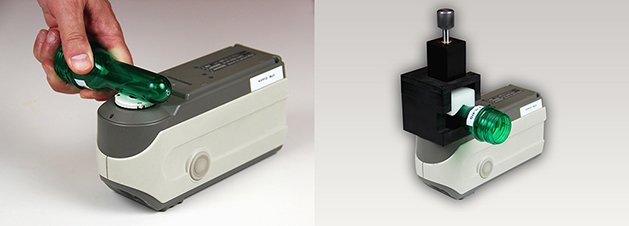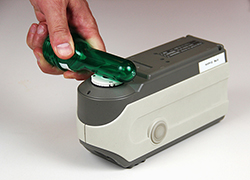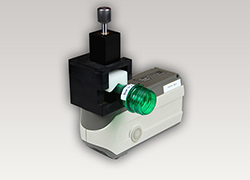Sample Preparation and Presentation Best Practices for Accurate Color Measurement
Sample Preparation
- Maintain consistency in sample thickness, size, and quantity for each measurement reading by grinding, mixing, cutting/slicing, or folding the samples the same before each measurement
- For translucent or transparent samples, fold the sample until light cannot pass through. It should be folded the same amount of times for each measurement. If the sample cannot be folded, place a standard background behind the sample for each measurement. A background plain in appearance (e.g., white ceramic tile) is recommended so as not to affect measurement results
- For powders, granules, liquids, or other loose samples, place in the same clear container (e.g., petri dish) for each measurement
- Remove grease, dirt, or other residue from the samples so as not to affect the accuracy of the measurement readings
- For samples that are manufactured in elevated temperatures, the samples should cool to ambient temperature to stabilize any drift in color before measurements are taken
|
|
|
Sample Presentation
- Depending on the sample form and instrument being used, lay the sample flat on a surface, flat on top of the instrument’s measurement area, or at the same angle for each measurement reading
- For powders, granules, or other loose samples, refills from the same sample batch are usually required between measurements to maintain the same level of sample for each measurement reading
- For multi-colored, patterned, or streaked samples, position the sample in the same direction for each measurement. A 90 degree rotation or change in measurement location on the sample may be required between each measurement reading to get a good representation of the sample’s color
Please note, if inconsistencies occur, averaging may be required. See Best Practices for Averaging the Color of Your Samples.
If a sample cannot be measured consistently, measure it as the “standard” first. Then, remove it and measure it again as the “sample.” If the color difference (ΔE*ab) between these measurements is .25 or higher, then it probably can’t be measured accurately or consistently. In cases like this, some of the variables involved could be the sample itself, how the sample is presented to the instrument, or the user may not have the appropriate instrument for this particular application.
The procedures established for preparing and presenting each sample for measurement should be documented and shared internally and throughout your supply chain. This ensures the same guidelines are adhered to for color consistency, accuracy, and operational efficiency.
Like this article? Click here to sign up for our monthly Color Trends & Technology newsletter to stay updated on the element of color, best practices for controlling and evaluating the color of objects, educational seminars, and advanced technology for research and manufacturing environments.
The technological leader in color and light measurement solutions, Konica Minolta Sensing Americas helps organizations formulate, evaluate, and control color to meet product quality and operational goals more efficiently.













